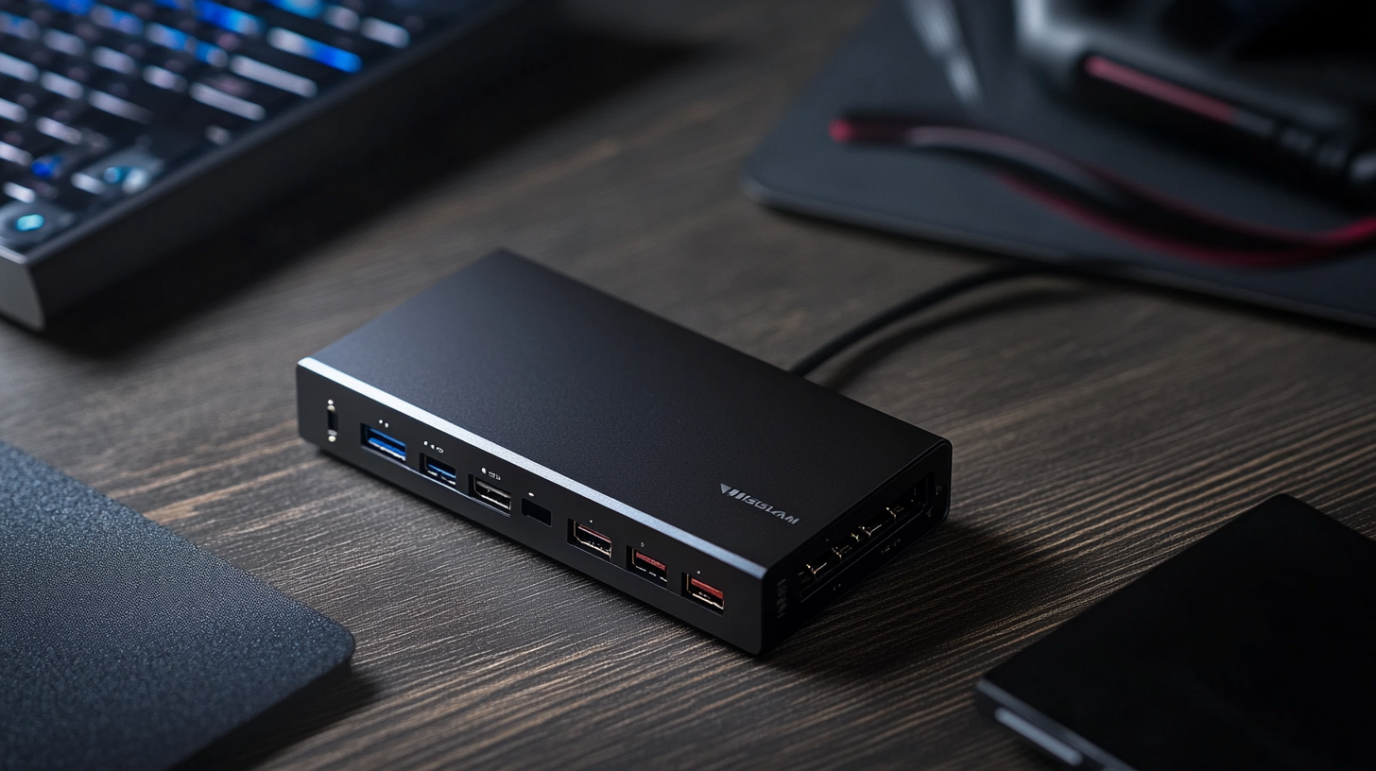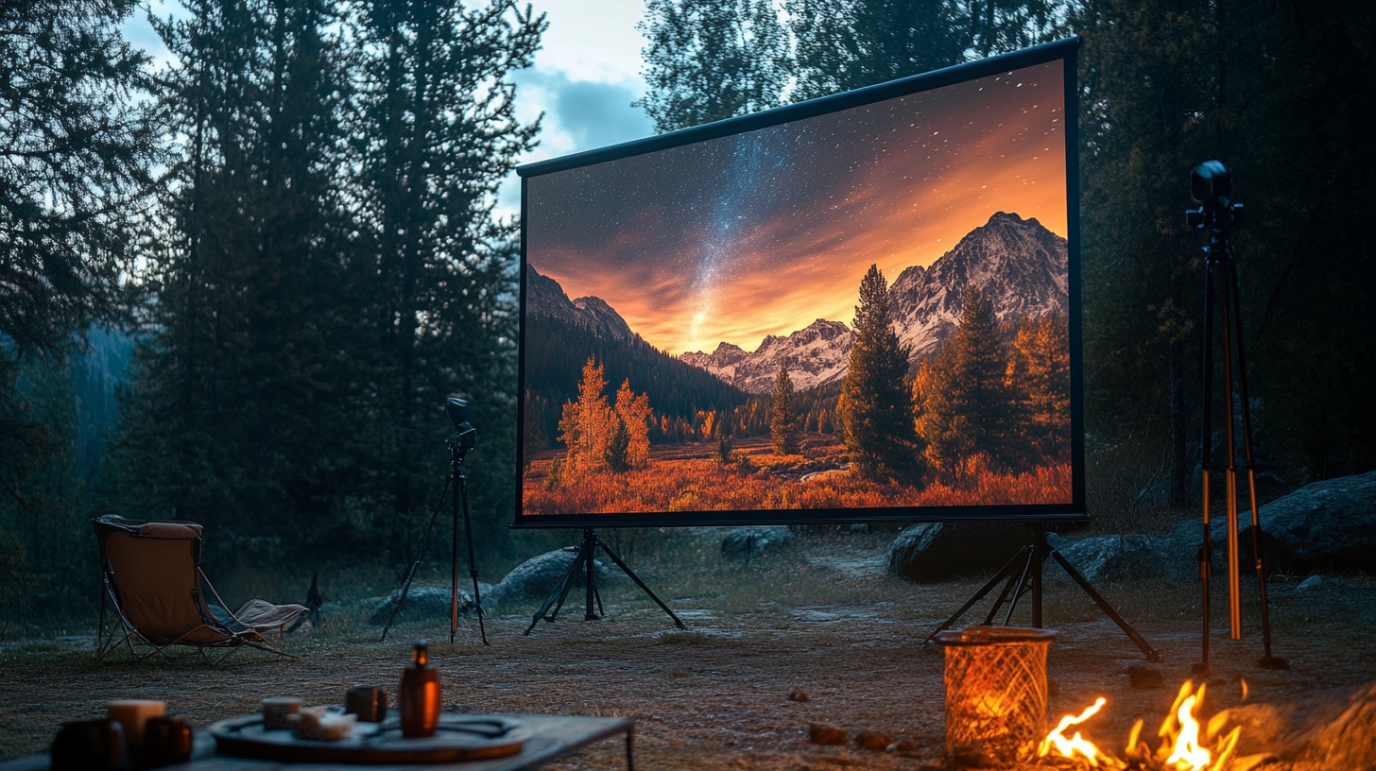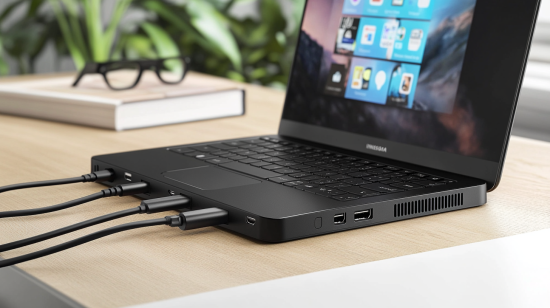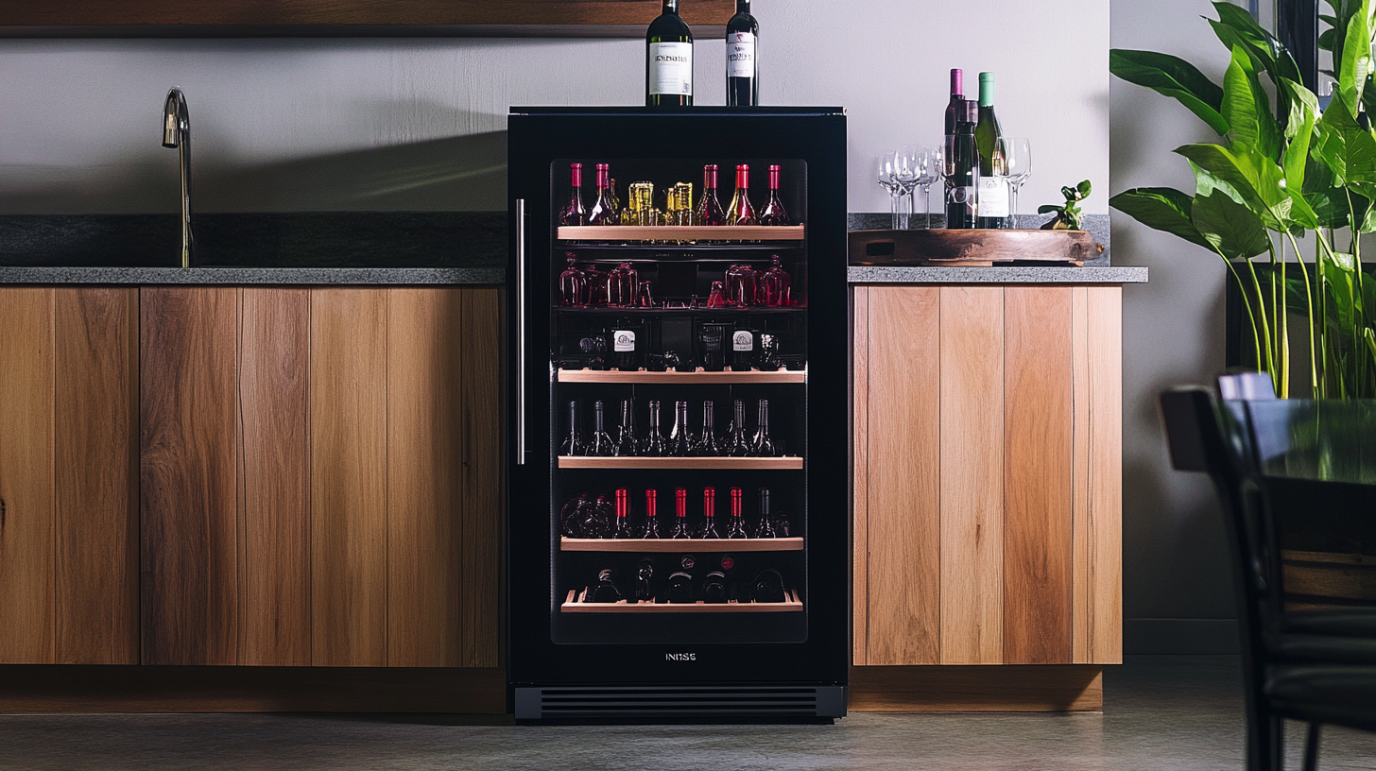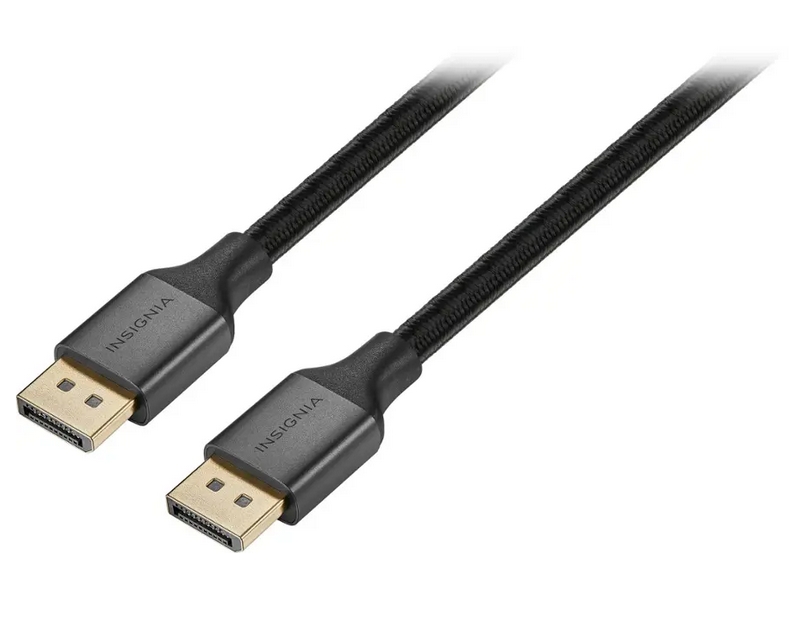
Insignia™ – 6′ DisplayPort Cable – Black
- Compatible with most DisplayPort devices
- Connects a DisplayPort video source to a display or monitor.
- 20-pin DisplayPort connector
- Promotes reliable signal transfer.
- Supports up to 4K resolution at 120 Hz
- A resolution of 3840 × 2160 at 120 Hz displays true-to-life images.
- Max bandwidth of 21.6 Gbps
- Allows for higher refresh rates, ideal for gaming and graphic design.
- Reliable transmission
- Transmits both video and audio signals.
- Plug-and-play technology
- Requires no additional software for an effortless connection.
- Fully shielded design
- This durable cable protects against interference for better video quality.
- Flexible placement options
- A 6 ft. cable gives you that extra needed length.
$19.99
Navigating the Digital Pipeline That Powers Your Visual Experience
As I sit here in my home office, surrounded by multiple displays showing everything from spreadsheets to the latest AAA game release, I can’t help but reflect on the humble cable that makes it all possible. That unassuming black cord connecting my graphics card to my monitor is the unsung hero of my setup. Today, I’m pulling back the curtain on what might seem like a mundane purchase but is actually the critical link in your visual computing chain: the Insignia DisplayPort Cable.
I’ve spent years building custom PCs, setting up gaming rigs, and optimizing workstations for creative professionals. Along the way, I’ve learned that not all DisplayPort cables are created equal, and the right choice can mean the difference between a frustrating experience and digital nirvana. So grab your favorite beverage, settle in, and let me guide you through everything you need to know about Insignia DisplayPort Cables.
What Exactly Is an Insignia DisplayPort Cable?
Let’s start with the basics. Insignia is Best Buy’s in-house brand that offers various tech accessories, including DisplayPort cables. But what is DisplayPort anyway? Unlike the more commonly known HDMI, DisplayPort was developed specifically with computer displays in mind, originating from the Video Electronics Standards Association (VESA).
The Insignia DisplayPort Cable is essentially a digital display interface designed to connect a video source to a display device. But it’s so much more than that. When I first switched from HDMI to DisplayPort for my gaming setup, the difference was immediately noticeable. The cable itself looks similar to HDMI but with a unique connector featuring a latch that prevents accidental disconnections – something I particularly appreciate when I’m in the middle of an intense gaming session or working on a deadline-critical project.
The Insignia brand offers these cables in various specifications, from the older DisplayPort 1.2 standard to the newer 1.4 version, with different lengths to accommodate various setups. They’re designed to deliver high-resolution video and audio signals with excellent fidelity.
The Cost Factor: Is Insignia Worth Your Hard-Earned Cash?
I’ve always been suspicious of both ultra-cheap cables that seem too good to be true and the gold-plated premium options that cost more than some actual components. Insignia positions itself in that sweet spot in between.
From my experience and research, Insignia DisplayPort Cables typically range from $19.99 to $39.99, depending on the length and specification. The 6-foot DisplayPort 1.4 cable, which is their most popular option, usually retails around $24.99. I’ve seen occasional sales bringing this down to around $19.99, which is when I typically stock up.
Is this a good value? In my opinion, absolutely. I’ve tried the $9.99 no-name brands from various online marketplaces, and the difference in build quality is immediately apparent. The Insignia cables have a more robust construction, better shielding, and more reliable connectors. They don’t break the bank like some premium brands charging $50+ for essentially the same specifications.
What you’re paying for with Insignia is reliability and peace of mind. I’ve never had one fail on me, which is more than I can say for some of the bargain-bin alternatives I’ve tried in the past.
Where to Buy: Sourcing Your Insignia DisplayPort Cable
Being Best Buy’s in-house brand, the most straightforward place to purchase an Insignia DisplayPort Cable is at Best Buy’s physical stores or their online marketplace. This is actually a significant advantage – you can walk into a store today and walk out with exactly what you need, which has saved me on more than one deadline crunch.
Beyond Best Buy, I’ve occasionally spotted these cables on Amazon, though the selection is typically more limited. Some other electronics retailers may carry them, but availability can be spotty.
One tip I’d offer from personal experience: if you’re planning to buy in-store, use Best Buy’s website to check stock at your local store first. There’s nothing more frustrating than driving across town only to find they’re sold out of the specific length or version you need.
Also, keep an eye out for Best Buy’s frequent accessory sales. I’ve saved significant money by timing my purchases with these promotions, sometimes getting up to 30% off the regular price.
The Technical Rundown: Features That Matter
Let’s get into the nitty-gritty of what makes these cables tick. The Insignia DisplayPort Cable lineup offers several key features that make them stand out:
DisplayPort Standards Support
Insignia offers cables supporting both DisplayPort 1.2 and the newer 1.4 standard. This matters significantly for what you can do with your setup.
The DisplayPort 1.2 cables support:
- 4K resolution at 60Hz refresh rate
- Up to 21.6 Gbps bandwidth
- Multi-Stream Transport for daisy-chaining monitors
Meanwhile, the DisplayPort 1.4 version steps things up with:
- 8K resolution at 60Hz or 4K at 120Hz
- Up to 32.4 Gbps bandwidth
- HDR support
- Display Stream Compression
I personally made the switch to DisplayPort 1.4 when I upgraded to a high-refresh-rate gaming monitor, and the difference was night and day. Being able to run games at 144Hz in 1440p resolution transformed my gaming experience.
Build Quality and Durability
One thing I appreciate about the Insignia cables is their construction. They feature:
- Gold-plated connectors for better signal integrity and corrosion resistance
- A latching mechanism that prevents accidental disconnections
- Robust strain relief at the connector points
- Thick outer sheathing that resists kinking and damage
I’ve accidentally rolled over my Insignia cable with my office chair countless times (sorry, cable!), and it’s still performing flawlessly after two years of daily use. That kind of durability matters, especially if you’re frequently reconfiguring your setup.
Length Options
Insignia offers these cables in several lengths, typically:
- 3 feet (0.9 meters)
- 6 feet (1.8 meters)
- 10 feet (3 meters)
I’ve found the 6-foot option to be the sweet spot for most desktop setups, giving enough slack to route cables cleanly without excessive length creating management issues. However, if you’re mounting a display on a wall or have an unusual desk configuration, the 10-foot option provides welcome flexibility.
One word of caution from my experience: with DisplayPort, quality matters more as length increases. I’ve noticed that with cheaper cables, signal degradation can become an issue at longer lengths, particularly when pushing higher resolutions and refresh rates.
Compatibility: Will It Work With Your Devices?
The most important question when buying any cable is whether it will work with your specific devices. Insignia DisplayPort Cables are designed to be broadly compatible with any device featuring a standard DisplayPort connection.
On the computer side, this includes:
- Most modern graphics cards from NVIDIA, AMD, and Intel
- Many business-class laptops with DisplayPort outputs
- Desktop PCs with integrated or dedicated graphics featuring DisplayPort
On the display side, compatible devices include:
- Gaming monitors with DisplayPort inputs
- Professional monitors, particularly those aimed at creative work
- Some high-end televisions (though DisplayPort is less common on TVs than HDMI)
One particularly useful feature of DisplayPort is its backward compatibility. A newer DisplayPort 1.4 cable will work perfectly with older DisplayPort 1.2 devices; you’ll simply be limited to the capabilities of the older standard.
I learned this lesson when upgrading my graphics card to a newer model with DisplayPort 1.4 support, while my monitor was still a DisplayPort 1.2 device. I didn’t have to replace my cable immediately, though I eventually did to take full advantage of my new hardware.
4K Compatibility: Crystal Clear Resolution
For many users, 4K resolution is a primary concern when selecting a display cable. The good news is that all Insignia DisplayPort Cables, even the older 1.2 standard versions, support 4K resolution.
However, there’s an important distinction to make:
- DisplayPort 1.2 cables support 4K at 60Hz refresh rate
- DisplayPort 1.4 cables support 4K at up to 120Hz refresh rate with full color depth
When I first set up my 4K editing monitor, I was initially using an older HDMI cable and couldn’t figure out why I was limited to 30Hz, which caused noticeable lag when moving windows or scrolling through content. Switching to a DisplayPort connection immediately solved the issue, allowing me to enjoy the full 60Hz capability of my monitor.
If you’re planning to use your setup for both productivity and entertainment, the ability to display 4K HDR content is invaluable. The Insignia DisplayPort 1.4 cables fully support this, making them ideal for a dual-purpose workstation.
High Refresh Rates: Smooth as Butter
For gamers and anyone who values smooth on-screen motion, refresh rate is as important as resolution – if not more so. This is where DisplayPort truly shines compared to many HDMI implementations.
The Insignia DisplayPort 1.2 cables support:
- 1080p resolution at up to 240Hz
- 1440p resolution at up to 144Hz
- 4K resolution at up to 60Hz
Moving up to the DisplayPort 1.4 standard with Insignia cables enables:
- 1080p resolution at up to 360Hz
- 1440p resolution at up to 240Hz
- 4K resolution at up to 120Hz
I still remember the first time I experienced a true 144Hz display after years of 60Hz monitors – it was like getting glasses after not realizing you needed them. Everything was suddenly smoother, from mouse movements to scrolling web pages, and especially in fast-paced games.
One technical note I’ve found important: to achieve these high refresh rates, you need to ensure your entire setup supports them – the cable is just one link in the chain. Your graphics card, monitor, and the DisplayPort version they support all need to align for optimal performance.
Cable Length: Finding Your Perfect Fit
Choosing the right cable length is about balancing convenience with signal integrity. Too short, and you’re constrained in how you position your devices. Too long, and you might encounter signal degradation or have a mess of excess cable to manage.
Insignia offers DisplayPort cables in standard lengths of 3, 6, and 10 feet. In my experience setting up various workstations:
- The 3-foot cable works well for compact setups where your PC sits on your desk near your monitor
- The 6-foot option (my personal preference) provides enough flexibility for most standard desk arrangements
- The 10-foot cable is ideal for situations where your PC might be on the floor, or you need to route the cable around furniture
I once made the mistake of buying a cable that was too short, thinking it would help keep my desk tidy. Instead, it limited how I could position my monitors and actually created more problems than it solved. I now always opt for at least the 6-foot version to give myself some breathing room.
One technical consideration: while DisplayPort is designed to maintain signal integrity over longer distances, I’ve found that when pushing the limits of resolution and refresh rate (like 4K at 120Hz), a shorter, high-quality cable tends to be more reliable than a longer one.
Backward Compatibility: Future-Proofing Your Purchase
One of the smartest features of the DisplayPort standard is its emphasis on backward compatibility, which Insignia cables fully support.
Here’s what this means in practice:
- A DisplayPort 1.4 cable will work with DisplayPort 1.2 ports (at 1.2 capabilities)
- Adapters can convert DisplayPort to HDMI, DVI, or even VGA for legacy displays
- The physical connector has remained the same across versions
This backward compatibility has saved me countless headaches. When I upgraded my graphics card to one with DisplayPort 1.4 outputs, I could continue using my older DisplayPort 1.2 monitor without any issues. Similarly, when I later upgraded my monitor, I could take advantage of the new features immediately.
I’ve also found the DisplayPort-to-HDMI adapters to be remarkably reliable. When setting up a presentation on an older television with only HDMI inputs, a simple adapter allowed me to connect directly from my laptop’s DisplayPort output without any configuration hassles.
Connection Guide: Getting Set Up Properly
Connecting your Insignia DisplayPort Cable is straightforward, but there are some best practices I’ve learned over the years:
- Always power down your devices before connecting or disconnecting the cable
- Notice the orientation of the connector – it has a beveled edge that must align with the port
- When inserting, you’ll feel a slight click as the latching mechanism engages
- To disconnect, press the button on the connector while pulling gently – don’t just yank it out
One common mistake I see people make is forcing the connector. DisplayPort connectors have a specific orientation, and while it’s not as finicky as USB, jamming it in the wrong way can damage both the cable and your expensive hardware.
Another tip from my experience: if you’re setting up a multi-monitor configuration, connect one monitor at a time, powering up after each connection. This makes troubleshooting much easier if one connection isn’t working properly.
HDR Support: Bringing Your Content to Life
High Dynamic Range (HDR) content provides a wider range of colors and greater contrast, making images appear more vibrant and lifelike. If you’re investing in a modern display setup, HDR support is a feature you’ll want.
The Insignia DisplayPort 1.4 cables fully support HDR content, enabling:
- More vibrant colors with a wider color gamut
- Better contrast between light and dark areas
- Greater detail in both shadows and highlights
When I first connected my HDR-capable monitor using the Insignia DisplayPort 1.4 cable and loaded up some HDR content, the difference was striking. Colors had a depth and richness that standard content simply couldn’t match, and scenes with both bright and dark elements showed detail I hadn’t been able to see before.
It’s worth noting that to experience HDR, your entire setup needs to support it: your source device (like a PC with a compatible graphics card), the cable, and your display. The Insignia cable ensures that the connection itself isn’t the weak link in this chain.
DisplayPort 1.2 vs. 1.4: What’s the Difference?
Understanding the difference between DisplayPort 1.2 and 1.4 in the Insignia cable lineup helps you choose the right option for your needs:
DisplayPort 1.2 (introduced in 2010):
- Supports 4K resolution at 60Hz
- Up to 21.6 Gbps bandwidth
- Basic Multi-Stream Transport for connecting multiple monitors
- Standard color depth
DisplayPort 1.4 (introduced in 2016):
- Supports 8K resolution at 60Hz or 4K at 120Hz
- Up to 32.4 Gbps bandwidth
- Enhanced Multi-Stream Transport
- HDR support
- Display Stream Compression (DSC)
- Higher color depth
In my experience, if you’re setting up a basic office workstation with standard 1080p or 1440p monitors running at 60Hz, the DisplayPort 1.2 cables are perfectly adequate. However, if you’re a gamer, creative professional, or want to future-proof your setup, the DisplayPort 1.4 option is well worth the small premium.
I made the switch to DisplayPort 1.4 when I upgraded to a gaming monitor with 144Hz refresh rate and HDR support. The difference was immediately noticeable not just in games, but in everyday tasks where the smoother motion made everything feel more responsive.
Durability: Built to Last
Cable durability might not seem like an exciting topic, but when a cable failure means downtime for your workstation or gaming rig, it suddenly becomes very important.
The Insignia DisplayPort Cables feature several design elements that enhance durability:
- Thick outer jacket resistant to cuts and abrasion
- Robust strain relief at connector points to prevent internal wire breakage
- Gold-plated connectors that resist corrosion
- Solid latching mechanism that maintains a secure connection
From my personal experience, these cables hold up well to daily use. I’ve accidentally rolled over mine with office chairs, had them tugged by an enthusiastic pet, and reconfigured my setup multiple times without any degradation in performance.
One small gripe I do have is that the latching mechanism, while secure, can be a bit stiff when new. This improves with use, but the first few times you disconnect the cable, you’ll want to be careful to press the release button fully before attempting to remove it.
User Reviews: The Verdict from the Field
I’m not alone in my positive experience with Insignia DisplayPort Cables. Looking at user reviews across various platforms, the consensus is generally favorable:
Positive points frequently mentioned include:
- Reliable performance at advertised specifications
- Good build quality compared to budget alternatives
- Consistent connection without signal dropouts
- Fair pricing relative to performance
The few criticisms tend to center around:
- Occasional units with stiff latching mechanisms
- Some users finding the cable thickness makes routing challenging in tight spaces
- Rare instances of DOA (dead on arrival) units
I’ve personally purchased three of these cables over the years for different setups, and all have performed flawlessly. The most recent one has been in daily use for over two years with no sign of degradation or performance issues.
One review that stuck with me mentioned how the Insignia cable solved persistent flickering issues the user was experiencing with a cheaper cable. This matches my experience – when it comes to digital signals, especially at high bandwidths, quality matters.
Competitive Comparison: How Does Insignia Stack Up?
The DisplayPort cable market includes everything from no-name brands to premium options from companies like Accell, Cable Matters, and Amazon Basics. How does Insignia compare?
In the budget category (under $15):
- Insignia offers better build quality and more reliable connectors
- No-name brands may work initially but often show signal issues over time
- Insignia provides a warranty and return option through Best Buy
In the mid-range category ($15-30, where Insignia sits):
- Insignia competes favorably with Amazon Basics and Cable Matters
- All offer similar specifications and generally reliable performance
- Insignia’s in-store availability gives it an edge for immediate needs
In the premium category ($30+):
- Brands like Accell offer marginally better construction
- Some premium brands include additional shielding for environments with high EMI
- The performance difference rarely justifies the price increase for most users
I’ve tried cables from across this spectrum, and my conclusion is that Insignia hits the sweet spot of value for most users. The improvement over budget cables is significant, while the step up to premium cables yields diminishing returns unless you have very specific requirements.
Audio Transmission: One Cable for Sight and Sound
One of the convenient features of DisplayPort is its ability to carry both video and audio signals through a single cable. The Insignia DisplayPort Cables fully support this functionality, enabling:
- Up to 8-channel audio transmission
- High-resolution audio formats
- Simplified cable management with one less cable to worry about
I’ve found this particularly useful when connecting to monitors with built-in speakers. For my secondary monitor that I occasionally use for watching videos or casual gaming, being able to get both picture and sound through a single connection simplifies my setup considerably.
It’s worth noting that audio transmission depends on your source device supporting audio output through DisplayPort. Most modern graphics cards do, but it’s always worth checking the specifications of your specific hardware.
Gaming Performance: Leveling Up Your Experience
As an avid gamer, I can confidently say that the right DisplayPort cable makes a significant difference in gaming performance. The Insignia DisplayPort Cables, particularly the 1.4 version, deliver several gaming-critical features:
- Support for high refresh rates (up to 360Hz at 1080p)
- Low latency signal transmission
- Adaptive sync technology compatibility (G-Sync and FreeSync)
- HDR gaming support
The difference between gaming at 60Hz and 144Hz or higher is dramatic – everything feels more responsive, from mouse movements to in-game actions. The Insignia cable ensures that your connection isn’t limiting your experience.
I particularly appreciate the compatibility with adaptive sync technologies. When I upgraded to a G-Sync compatible monitor, the elimination of screen tearing without the performance hit of traditional V-sync was a game-changer, especially in fast-paced competitive games.
For serious gamers, I recommend nothing less than the DisplayPort 1.4 version of the Insignia cable, paired with a compatible monitor and graphics card. The combination unlocks the kind of smooth, responsive gaming experience that can actually improve your performance in competitive titles.
Warranty and Support: Peace of Mind
Insignia DisplayPort Cables come with Best Buy’s standard warranty policy, which typically includes:
- 1-year limited warranty against manufacturing defects
- Exchange or refund options if issues arise
- Access to Best Buy’s customer support
I’ve only had to use this warranty once, not for an Insignia cable but for another Insignia product. The process was straightforward – I brought the defective item back to my local Best Buy with the receipt, and they exchanged it on the spot.
This level of support is one of the advantages of purchasing from an established retailer’s house brand rather than anonymous online sellers. If something goes wrong, you have a clear path to resolution.
Additionally, Best Buy’s tech support can help troubleshoot connection issues, though in my experience, most DisplayPort problems are resolved by ensuring you have the right cable specification for your needs and that all your hardware is compatible.
Finding the Best Deal: Discounts and Promotions
Like most tech accessories, Insignia DisplayPort Cables frequently go on sale. Based on my bargain-hunting experience, here are some tips for getting the best price:
- Best Buy runs accessory sales several times a year, often discounting these cables by 20-30%
- Holiday shopping periods like Black Friday and Cyber Monday typically offer good deals
- Best Buy’s deal-of-the-day promotions occasionally feature these cables
- Open-box options can save you 10-15% if you’re comfortable with that
I typically stock up when I see these cables on sale, as having spares has saved me more than once when setting up temporary workstations or helping friends with their setups.
One strategy I’ve found effective is to add the cable to your Best Buy wish list and enable notifications. You’ll receive alerts when the price drops, allowing you to time your purchase optimally.
Troubleshooting: When Things Don’t Work
Even the best cables can sometimes encounter issues. Here are some troubleshooting steps I’ve found effective for DisplayPort connection problems:
- Check physical connections – ensure the cable is fully seated at both ends with the latch engaged
- Power cycle your devices – turn off both the source and display, disconnect power for 30 seconds, then reconnect
- Try a different port – both on your graphics card and monitor if available
- Update your graphics drivers – outdated drivers can cause compatibility issues
- Check your display settings – ensure you’re not trying to push resolution or refresh rate beyond what your hardware supports
- Test with another cable if possible to isolate whether the issue is the cable or something else
The most common issue I’ve encountered is a loose connection. The DisplayPort latch is designed to prevent this, but sometimes it doesn’t fully engage. A simple disconnect and reconnect, ensuring you feel the click of the latch, often resolves intermittent display problems.
Another frequent issue occurs when trying to run at specifications beyond what your hardware supports. For example, if you’re trying to run a 4K display at 120Hz with a graphics card that only supports 4K at 60Hz, you’ll encounter problems regardless of cable quality.
The Final Verdict: Is the Insignia DisplayPort Cable Right for You?
After using various Insignia DisplayPort Cables across multiple setups over the years, my conclusion is that they offer excellent value for most users. They strike the right balance between performance, durability, and price.
They’re particularly well-suited for:
- Gamers looking to take advantage of high refresh rate monitors
- Professionals who need reliable 4K display support
- Anyone setting up a multi-monitor workstation
- Users who want a dependable cable without paying premium prices
The only scenarios where I might recommend looking elsewhere are:
- If you need specialized features like fiber optic cables for very long runs
- If you’re dealing with unusual installation requirements that need extra flexibility
- If you’re operating in environments with extreme electromagnetic interference
For the vast majority of users, the Insignia DisplayPort Cable, particularly the DisplayPort 1.4 version, provides everything you need to get the most out of your modern display setup.
As I look at my three-monitor setup, powered by Insignia DisplayPort Cables for over two years without a single hiccup, I can confidently say that these unassuming black cables are the critical link in your visual computing chain – and they deserve more consideration than most people give them.
Whether you’re fragging opponents in the latest shooter at 144Hz, color-grading video projects in HDR, or simply want the clearest, most reliable connection for your everyday computing, the Insignia DisplayPort Cable delivers without breaking the bank.


